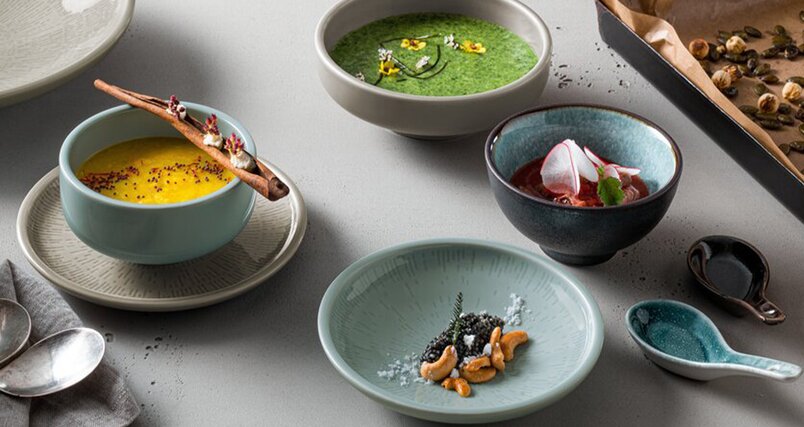Even if the culinary delights are the main focus when visiting a restaurant, it is not least the lighting and thus the atmosphere that makes the evening an all-round enjoyable experience. To make your guests feel comfortable and keep their visit to your restaurant in good memory, you should provide a suitable lighting concept. We give you seven tips for proper lighting in gastronomy.
1. Importance of light in gastronomy
Lighting in gastronomy should be not only functional, but also aesthetically pleasing. Because the lighting accentuates the design of the room and enhances its effect. It is therefore important to choose the lamps in terms of materials, shapes and colors so that they match the interior style of the restaurant and contribute to a harmonious overall image.
The lighting also reflects the ambition of the gastronomy and the level of cuisine. If the light sources are tastefully combined and arranged, then it will allow your guests to conclude that the restaurant has a high standard. Whereas a purely functional lighting rather testifies to a simple kitchen.
2. Basic restaurant lighting
Guests prefer restaurant lighting that creates a comfortable atmosphere for conversation. This can be achieved with a low, dimmed background illumination. To create this, install light sources at the tables and at the counter to provide a basic diffuse brightness of between 50 and 100 lux in the rooms. For orientation in the rooms and recognition of faces, this lighting intensity is completely sufficient.
For larger venues, it is recommended to use additional ceiling or wall luminaires that emit indirect light through a transparent shade and light up the area around them. In addition, by using accent lights, cove lights or designer lights, invigorating light contrasts or fancy lighting accents can be added to arouse the guests' curiosity, create an eye-catcher and set gentle, stylish accents.
3. Lighting solutions for flexible room use
Depending on the restaurant concept, restaurant rooms are occasionally used for weddings, corporate parties, birthdays and other occasions by larger groups. This requires flexible solutions for basic and spot lighting, which conjure up the right lighting ambience to suit the respective situation. Recessed ceiling luminaires are particularly suitable for a flexible lighting design.
These can be installed in the ceiling in the desired patterns and individually adjusted in brightness, color and color gradient using the central lighting control system. In this way, they provide a source of light that can be integrated into any concept.
4. The ideal table lighting in restaurants
For table lighting, many restaurateurs rely on pendant lights. These emit downward light that is bright enough and direct enough to allow guests to read the menu and eat the food easily. In addition, pendant lights contribute to the basic lighting of the room, as their indirect light beams also illuminate the near surroundings of the tables.
Pendant light shades should start about 60 to 80 centimeters above the tabletop to avoid distracting glare or obstructing the view. When selecting pendant lights, you can go for models that allow individual height adjustment. Also ensure that the light cone of the pendant light harmonizes with the size of the table.
5. Presenting the bar and counter using light
In many restaurants, the bar is of great importance because it is usually the first area guests see when they walk in. To effectively spotlight this important point of contact, a bar concept with appropriate lighting design should be created. To make the bar eye-catching, several pendant lights with a shielded light source can be installed, effectively illuminating the counter with their downward light beams.
In addition, fancy design lights, LED strip lights or background lights can give the restaurant bar special attention and its own unique character. Likewise the use of glass bottom lighting is popular, which gives the bottles and glasses sparkling light reflections. Mix the different types and qualities of lighting to achieve an exciting bar design. Generally, a subdued lighting level is sufficient for this.
6. Lighting for service area and walkways
To ensure that your service staff can perform their tasks safely and without errors, it is important to provide proper lighting for the service area and walkways. Bright, direct light could be perceived as disturbing by guests in a subdued lighting ambience. A solution is to set up a service area behind the counter, lit by spotlights or shielded luminaires. The light sources shining directly downwards should have a strength of at least 300 lux. For the traffic routes, mainly planar wall lighting is suitable, which by its vertical light shows the room layout and at the same time also illuminates a part of the floor. Alternatively, decorative wall lights or wall washers providing a warm white light can be installed.
7. Selecting efficient lamps
Among all types of lamps, halogen lamps provide the best quality of light. They emit a brilliant, clear light that closely resembles natural daylight and reproduces the colors of objects particularly well. Among the most effective halogen lamps are low-voltage halogen lamps with an IRC coating and electronic ballast.
However, even though the use of halogen lamps is widespread in gastronomy, it should be understood that these bulbs have a higher power consumption and a shorter service life compared to others. Especially in restaurants, where the light is on for more than five hours a day, the use of efficient and long-lasting LED lamps should be considered.
By the way, you can find tips on how to save energy in this article.











